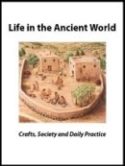Who is the Wise Woman of Abel Beth Maacah? In 2 Samuel 20:14–22, this woman stands up to Joab, the commander of King David’s army, and adroitly negotiates the salvation of her town. Why does Joab listen to her?
In their article “The Wise Woman of Abel Beth Maacah” published in the July/August/September/October 2019 issue of Biblical Archaeology Review, Nava Panitz-Cohen and Naama Yahalom-Mack of the Hebrew University of Jerusalem investigate this biblical figure. Along with Robert Mullins of Azusa Pacific University, Panitz-Cohen and Yahalom-Mack direct excavations at the site of Tel Abel Beth Maacah in northern Israel. Their excavations provide insight into the figure of the Wise Woman of Abel Beth Maacah.
The Bible mentions two wise women: the Wise Woman of Tekoa (2 Samuel 14) and the Wise Woman of Abel Beth Maacah (2 Samuel 20). Both women appear in narratives connected to King David’s reign. They act wisely and authoritatively. They give advice, which is heeded by powerful men—King David in the first instance and Joab in the second.

Who were these wise women in the Bible? Were they just shrewd women, or did they fill a more formal role in society? Should we view them as female seers? Panitz-Cohen and Yahalom-Mack investigate the archaeological discoveries at Tel Abel Beth Maacah and the biblical text for the answers to these questions.

Aerial view of the Iron Age public complex from Area A at Abel Beth Maacah; note the Iron IIA stone pavement on the lower right, where the astragali jar was found. Photo: Robert A. Mullins.
At Tel Abel Beth Maacah, the excavators have found several rooms with cultic paraphernalia in a large public building. One room dates to the late 11th or early tenth century B.C.E. (late Iron Age I). Another room, a stone-paved courtyard, dates to the late tenth–ninth centuries B.C.E. (Iron IIA). Notably, archaeologists uncovered a jar holding 425 astragali (ankle bones) of sheep, goats, and deer on a podium in the courtyard. Astragali have been found in excavations throughout the ancient Near Eastern and Mediterranean world. Panitz-Cohen and Yahalom-Mack explain the different scholarly interpretations for their purpose: “They may have been used as game pieces, or they may have been used in ritual activities, such as divination, as well as in political advisory.” For example, astragali may have been used in cleromancy (casting lots to foretell the future).

The space with remains of ritual activity in the north of the Iron I public complex; note the basins, stone offering table, masseboth (“standing stones,” which are lying down here), and plastered clay installation with a double “sink” on top. Photo: Robert A. Mullins.
Although the exact purpose of the astragali from the jar is unknown, the authors contend that such a large collection probably featured in a ritual activity. This fits well with their interpretation of Abel Beth-Maacah as a potential center of oracular wisdom, a place people visited to have their questions answered—something the Wise Woman of Abel Beth Maacah herself asserts in 2 Samuel 20:18, when she tells Joab, “They used to say in the old days, ‘Let them inquire at Abel’; and so they would settle a matter.”

The reconstructed cult stand from the Iron I ritual space. Photo: Tal Rogovski; restoration: Ora Mazar.
Should then the Wise Woman of Abel Beth Maacah and the Wise Woman of Tekoa be viewed as female seers? In the Bible, they are not called seers. However, the authors identify wise women in other ancient texts who were considered ritual experts:
Interestingly, wise women (sometimes termed “old women”) are also mentioned in Late Bronze Age (1550–1200 B.C.E.) Hittite texts as ritual experts who operated based on folk knowledge, practicing a range of divinatory and magical tasks, which included fer¬tility rites, healing, and protection against plague or other misfortunes.
The comparison is interesting. Panitz-Cohen and Yahalom-Mack clarify that they are not claiming that the Wise Woman of Abel Beth Maacah definitively practiced divination or served as spiritual leader—but she may have. Part of her authority likely stemmed from her town’s reputation as a place of wisdom.
Whether or not biblical wise women were seers, we can say that they filled a public role in society, which was political and authoritative. Learn more about the Wise Woman of Abel Beth Maacah and the ongoing excavations at Abel Beth Maacah in Nava Panitz-Cohen and Naama Yahalom-Mack’s article “The Wise Woman of Abel Beth Maacah” published in the July/August/September/October 2019 issue of Biblical Archaeology Review.

Chris Chandler and Abbie Mantor of Asbury Theological Seminary find traces of the fiery destruction of the Iron Age I public complex. Photo: Robert A. Mullins.

A proud Jeff Kobs excavates the astragali jar from the Iron IIA courtyard. Photo: Tel Abel Beth Maacah Excavations.

Co-directors Nava Panitz-Cohen and Robert Mullins, together with Fredrika Loew, the supervisor of Area A, proudly beam over the astragali jar. Photo: Tel Abel Beth Maacah Excavations.

The restored astragali jar from the Iron IIA courtyard. Photo: Tal Rogovski; restoration: Ora Mazar.

The “wise women” of Tel Abel Beth Maacah (season 2018) humorously attempt to behead excavation co-director Robert Mullins. Photo: Moshe Cohen.
Subscribers: Read the full article “The Wise Woman of Abel Beth Maacah” by Nava Panitz-Cohen and Naama Yahalom-Mack in the July/August/September/October 2019 issue of Biblical Archaeology Review.
Not a subscriber yet? Join today.
This post originally appeared in BHD on July 15, 2019
More on Abel Beth Maacah in Bible History Daily:
Were There Arameans at Abel Beth Maacah?
Silver Hoard from Abel Beth Maacah Illuminates Biblical Border Town
An Iron Age Royal at Abel Beth Maacah?
The post Who Is the Wise Woman of Abel Beth Maacah? appeared first on Biblical Archaeology Society.



0 Commentaires